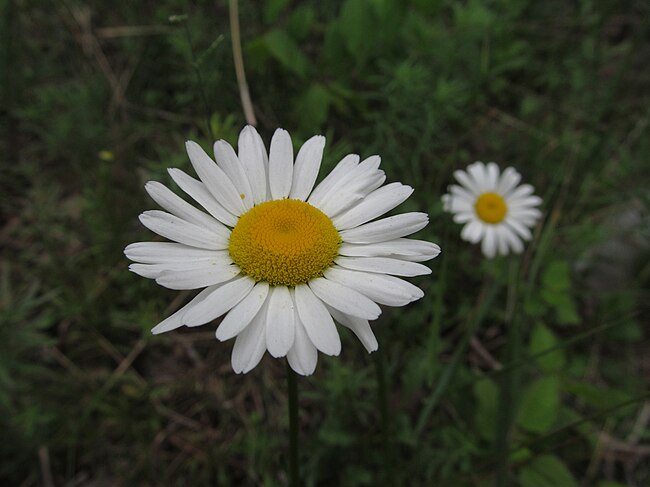
Daisies are sometimes weedy invaders, but it is almost impossible to hate them. They do sometimes form dense patches and crowd out native plants; but large patches like these are relatively infrequent, and they do not seem to pose a serious danger to our ecosystem.

There is no reason not to repeat what we said ten years ago:
This is the most universally beloved of all wild flowers, the focus of countless childhood traditions and the very image of “flower” in the popular imagination. It may be derided as a pernicious weed by agricultural and environmental authorities, but the ordinary citizen will never be persuaded to hate it.
Daisies like these were formerly kept in the genus Chrysanthemum, but have been removed by bored botanists to the genus Leucanthemum “because they are not aromatic and their leaves lack grayish-white hairs,” according to the Wikipedia article on the genus. (The genus “Leucanthemum” was apparently named by Lamarck, whose discredited theory of inheritance of acquired characteristics still haunts high-school biology classes.) Because of this new sorting of the genera, we leave Gray and give the description of the genus and species from the Flora of North America at efloras.org:

Leucanthemum Miller, Gard. Dict. Abr. ed. 4. vol. 2. 1754.
[Greek leuco-, white, and anthemon, flower]
John L. Strother
Perennials, (10–)40–130(–200+) cm (rhizomatous, roots usually red-tipped). Stems usually 1, erect, simple or branched, glabrous or hairy (hairs basifixed). Leaves mostly basal or basal and cauline; petiolate or sessile; blades obovate to lanceolate or linear, often 1[–2+]-pinnately lobed or toothed, ultimate margins dentate or entire, faces glabrous or sparsely hairy. Heads usually radiate, rarely discoid, borne singly or in 2s or 3s. Involucres hemispheric or broader, 12–35+ mm diam. Phyllaries persistent, 35–60+ in 3–4+ series, distinct, ovate or lance-ovate to oblanceolate, unequal, margins and apices (colorless or pale to dark brown) scarious (tips not notably dilated; abaxial faces glabrous or sparsely hairy). Receptacles convex, epaleate. Ray florets usually 13–34+, rarely 0, pistillate, fertile; corollas white (drying pinkish), laminae ovate to linear. Disc florets 120–200+, bisexual, fertile; corollas yellow, tubes ± cylindric (proximally swollen, becoming spongy in fruit), throats campanulate, lobes 5, deltate (without resin sacs). Cypselae ± columnar to obovoid, ribs ± 10, faces glabrous (pericarps with myxogenic cells on ribs and resin sacs between ribs; embryo sac development monosporic); pappi 0 (wall tissue of ray cypselae sometimes produced as coronas or auricles on some cypselae). x = 9.
Species 20–40+ (3 in the flora): introduced; mostly temperate Europe (some widely cultivated and sparingly adventive).
The three leucanthemums recognized here are weakly distinct and are sometimes included (with a dozen or more others) in a single, polymorphic Leucanthemum vulgare.
SELECTED REFERENCE
Vogt, R. 1991. Die Gattung Leucanthemum (Compositae–Anthemideae) auf der Iberischen Halbinsel. Ruizia 10: 1–261.
Leucanthemum vulgare Lamarck, Fl. Franç. 2: 137. 1779.
Ox-eye daisy, marguerite blanche
Chrysanthemum leucanthemum Linnaeus, Sp. Pl. 2: 888. 1753; C. leucanthemum var. pinnatifidum Lecoq & Lamotte
Perennials, 10–30(–100+) cm. Stems simple or distally branched. Basal leaves: petioles 10–30(–120) mm, expanding into obovate to spatulate blades 12–35(–50+) × 8–20(–30) mm, margins usually pinnately lobed (lobes 3–7+) and/or irregularly toothed. Cauline leaves petiolate or sessile; blades oblanceolate or spatulate to lanceolate or linear, 30–80+ × 2–15+ mm, margins of mid-stem leaves usually irregularly toothed proximally and distally.Involucres 12–20+ mm diam. Phyllaries (the larger) 2–3 mm wide. Ray florets usually 13–34+, rarely 0; laminae 12–20(–35+) mm. Ray cypselae 1.5–2.5 mm, apices usually coronate or auriculate. 2n = 18, 36, 54, 72, 90.
Flowering spring–fall. Disturbed places, meadows, seeps, clearings; 0–2000 m; introduced; Alta., B.C., Ont., Que., Sask.; Alaska, Ariz., Ark., Calif., Colo., Conn., Fla., Idaho, Ill., Ind., Iowa, Kans., Mass., Mich., Mo., Mont., Nev., N.Mex., N.Y., N.Dak., Ohio, Okla., Oreg., Pa., S.C., S.Dak., Tenn., Utah, Va., Wash., W.Va., Wis., Wyo.; Europe, widely adventive.
Some botanists (e.g., W. J. Cody 1996) have treated Leucanthemum ircutianum de Candolle, with blades of mid and distal cauline leaves oblong to oblong-lanceolate and not ± pinnate at bases, as distinct from L. vulgare.


